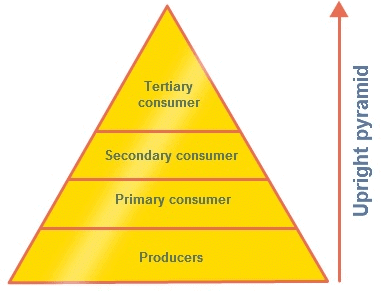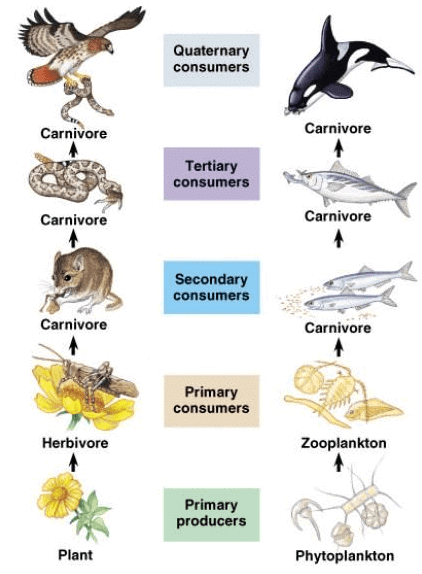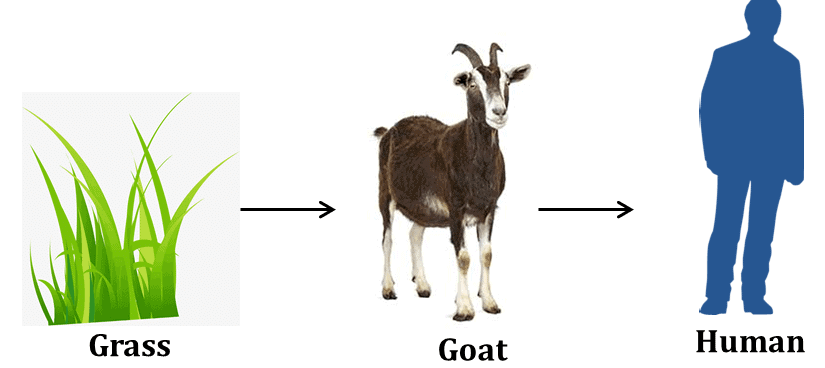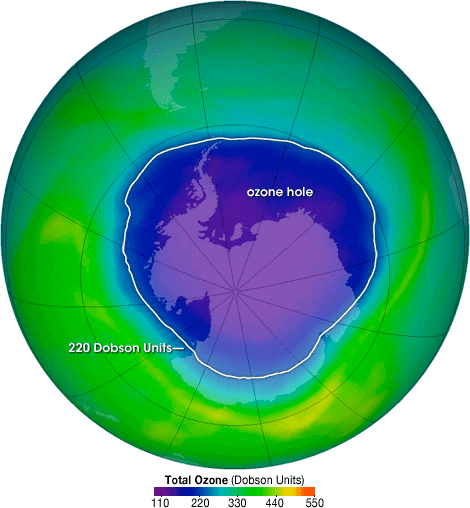NCERT Solutions for Class 10 Science Chapter 13 - Our Environment
Page No: 212
Q1: What are trophic levels? Give an example of a food chain and state the different trophic levels in it.
Ans:
- A trophic level is a level of species in an ecosystem based on the source of nutrition, such as producers, primary consumers, secondary consumers, etc.
- The producers form the first trophic level as they manufacture food; primary consumers form the second trophic level, the secondary consumers form the third, and the tertiary consumers form the fourth trophic level.

- Various trophic levels are connected through food chains.
Example: In an aquatic food chain, phytoplankton are the producers, zooplankton are the primary consumers, small fish are the secondary consumers, and so on.
Q2: What is the role of decomposers in the ecosystem?
Ans:
- Decomposers include micro-organisms such as bacteria and fungi that obtain nutrients by breaking down the remains of dead plants and animals.
- They help in the breakdown of organic matter or biomass from the body of dead plants and animals into simple inorganic raw materials, such as CO2, H2O, and some nutrients.
Page No. 214
Q1: Why are some substances biodegradable and some non-biodegradable?
Ans:
- Some substances, such as metal, glass, plastic, etc., which cannot be decomposed by living organisms, are non-biodegradable wastes.
- These substances are non-biodegradable because the microorganisms do not have enzymes that can digest these substances.
- Therefore, we classify them as non-biodegradable wastes.
- Other substances, such as paper, vegetable wastes, etc. that can be easily broken down by enzymes are biodegradable wastes.
Q2: Give any two ways in which biodegradable substances would affect the environment.
Ans: Biodegradable substances affect the environment in the following ways:
- Biodegradable substances such as tree leaves, plant parts, and kitchen wastes can be used as humus after composting. This will enhance soil fertility.
- Biodegradable substances mainly contain carbon. These substances, after decomposition, release that carbon back into the atmosphere.
Q3: Give any two ways in which non-biodegradable substances would affect the environment.
Ans: Non-biodegradable substances affect the environment in the following ways:
- They contaminate soil and water resources as they cannot be decomposed by microorganisms.
- These substances, when accidentally eaten by stray animals, can harm them and can even cause their death.
Page No. 216
Q1: What is ozone, and how does it affect any ecosystem?
Ans:
- Ozone is a colorless gas that acts as a screen for ultraviolet radiation.
- It is continuously formed at the higher levels of the atmosphere due to the action of UV rays on molecular oxygen.
- The high-energy UV radiations break down O2 molecules into nascent oxygen.

- Then, this free oxygen atom combines with an oxygen molecule to form ozone.

- In recent years, the amount of ozone in the atmosphere has been depleted.
- This ozone depletion causes a greater amount of ultraviolet radiation to enter the Earth’s atmosphere.
- This has an indirect effect on the ecosystem. (Ecosystem includes both the biological community and the non-living components of an area). It results in the death of many phytoplankton, thereby affecting the process of photosynthesis.
- Plants utilize atmospheric CO2 to make their food. In the absence of plants, the levels of CO2 in the atmosphere will increase, which would, in turn, lead to an increase in global warming.
- The depletion of the ozone layer also increases the frequency of infectious diseases as it suppresses the immune systems of both human beings and animals.
- The frequency of skin cancer also increases in human beings because of direct exposure to ultraviolet radiation.
Q2: How can you help in reducing the problem of waste disposal? Give any two methods.
Ans:
- Proper waste management can help solve the issue of waste disposal.
- By following these steps, we can manage waste more effectively and reduce its impact on our surroundings.
(i) Use separate bins (blue and green) to dispose of non-biodegradable and biodegradable wastes. (ii) Different garbage bins for disposing of biodegradable waste and non-biodegradable waste
(ii) Different garbage bins for disposing of biodegradable waste and non-biodegradable waste
(iii) Reduce the usage of non-biodegradable products such as plastics.
Exercise
Q1: Which of the following groups contain only biodegradable items?
(a) Grass, flowers, and leather
(b) Grass, wood, and plastic
(c) Fruit peels, cake, and lime-juice
(d) Cake, wood, and grass
Ans: (c) Fruit peels, cake, and lime-juice
(d) Cake, wood, and grass
Q2: Which of the following constitutes a food chain?
(a) Grass, wheat, and mango
(b) Grass, goat, and human
(c) Goat, cow, and elephant
(d) Grass, fish, and goat
Ans: (b) Grass, goat, and human
 Food Chain
Food Chain
Q3: Which of the following are environment-friendly practices?
(a) Carrying cloth bags to put purchases in while shopping
(b) Switching off unnecessary lights and fans
(c) Walking to school instead of getting your mother to drop you on her scooter
(d) All of the above
Ans: (d) All of the above
Q4: What will happen if we kill all the organisms at one trophic level?
Ans:
- Various trophic levels are connected through the food chains. If all the organisms of any one trophic level are killed, it will disrupt the entire food chain.
Example: In a food chain, if all the plants are killed, then all the deer will die due to lack of food. If all the deer are dead, then the tigers will die soon. Due to the death of these animals, the decomposer population will rise in that area. - This is just an example of one food chain. However, in nature, food chains are not isolated.
- They are interconnected in the form of food webs.
- Therefore, killing all the plants in an area will not only affect the deer, but it will also affect other herbivores such as goats, cattle, sheep, etc.
Q5: Will the impact of removing all the organisms in a trophic level be different for different trophic levels? Can the organisms of any trophic level be removed without causing any damage to the ecosystem?
Ans:
- Organisms of all trophic levels are equally important and are an integral part of the ecosystem.
- If all the producers are removed, then it will affect all the herbivores as it is their primary food source.
- The death of herbivores will soon affect the primary carnivores and so on.
- Now let us suppose that all the deer (herbivores) are killed in a region. This can lead to an increase in the number of producers.
- Simultaneously, there will be an increase in the number of other herbivores, such as rabbits, goats, sheep, etc., due to less competition.
- This will also lead to an increase in the population of only consumers of these increased herbivores. Thus, the balance in the ecosystem gets disturbed if any of its component organisms are removed.
Q6: What is biological magnification? Will the levels of this magnification be different at different levels of the ecosystem?
Ans:
- Biomagnification is the increase in the concentration of pollutants or harmful chemicals within each step of the food chain.
- The levels of biomagnification will be different at different trophic levels.
Example: In a pond of water, DDT was sprayed, and the producers were found to have 0.04 ppm concentration of DDT. Since many types of plankton are eaten by some fishes and clams, their body accumulates 0.23 ppm of DDT. Seagulls that feed on clams accumulate more DDT as one seagull eats many clams. Hawk, the top carnivore, has the highest concentration of DDT.
 Biomagnification
Biomagnification
Q7: What are the problems caused by the non-biodegradable wastes that we generate?
Ans: Non-biodegradable substances affect the environment in the following ways:
- Since the non-biodegradable substances cannot be broken down, they accumulate and thus contaminate the soil and the water resources.
- These substances, when accidentally eaten by some stray animals, can harm them and can even cause their death.
- These substances occupy more space in landfills and require special disposal techniques.
- These materials can accumulate in the environment and can also enter the food chain.
Q8: If all the waste we generate is biodegradable, will this have no impact on the environment?
Ans:
- The generation of only biodegradable waste will have a positive impact on the environment.
- There will not be any pollution caused by the non-biodegradable wastes.
- The problem associated with waste management and disposal will also not occur.
- The population of decomposers will increase to break down the extra biodegradable waste generated.
Q9: Why is damage to the ozone layer a cause for concern? What steps are being taken to limit this damage?
Ans:
- Ozone depletion occurs widely in the stratosphere.
- However, it is more prominent over the Antarctic region and is known as the ozone hole.
 Diagram Representing Ozone Hole
Diagram Representing Ozone Hole
Consequences of ozone depletion:
- It causes skin darkening, skin cancer, aging, and corneal cataracts in human beings.
- It can result in many phytoplankton deaths, which leads to increased global warming.
The steps taken to limit the damage:
- To limit the damage to the ozone layer, the release of CFCs into the atmosphere must be reduced.
- CFCs used as refrigerants and in fire extinguishers should be replaced with environmentally safe alternatives.
- Also, the release of CFCs through industrial activities should be controlled.
|
80 videos|569 docs|80 tests
|
FAQs on NCERT Solutions for Class 10 Science Chapter 13 - Our Environment
| 1. What is the importance of the environment in our daily lives? |  |
| 2. What are the major components of the environment? |  |
| 3. How do human activities impact the environment? |  |
| 4. What steps can individuals take to protect the environment? |  |
| 5. Why is it important to study environmental science? |  |

















